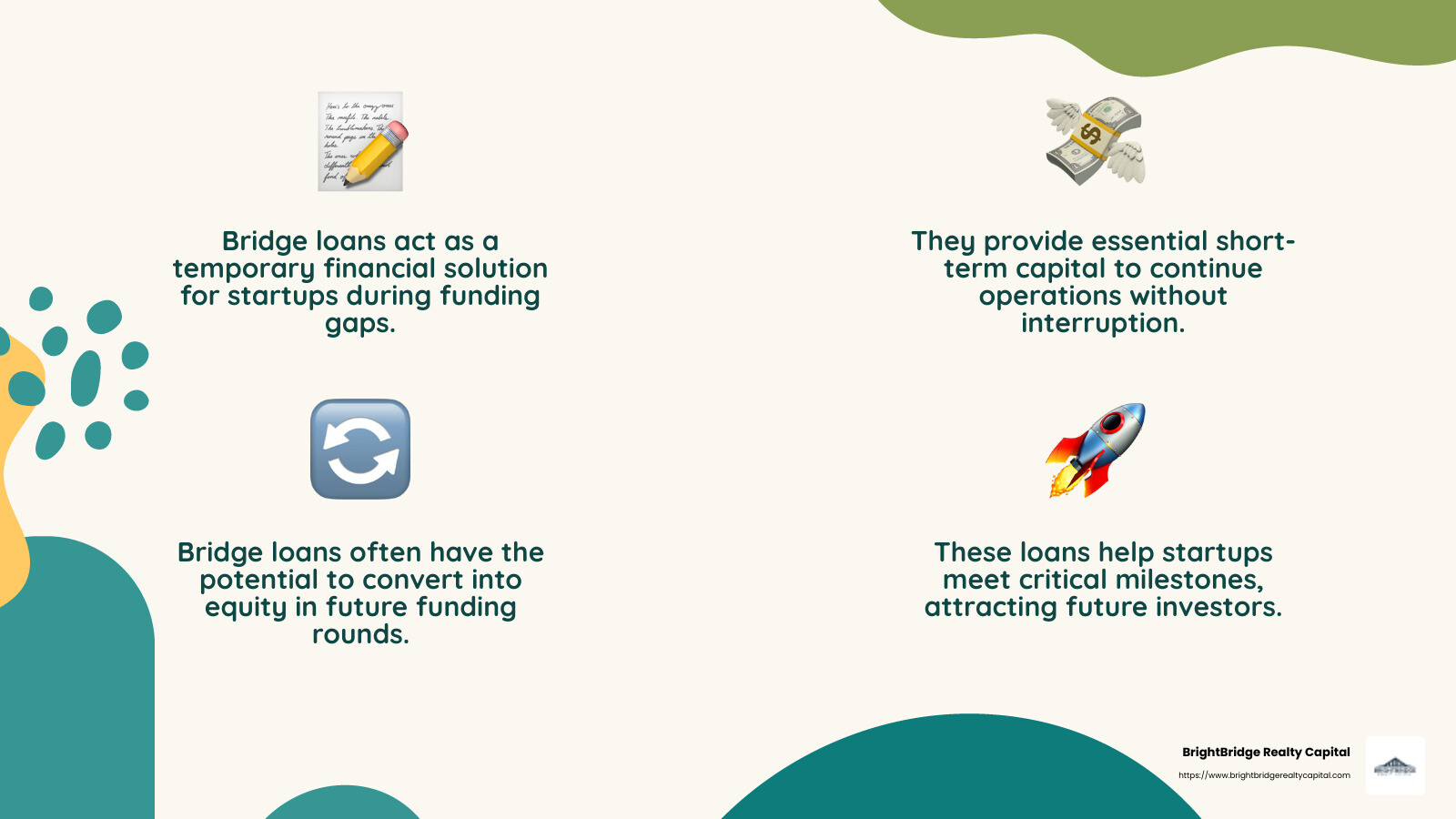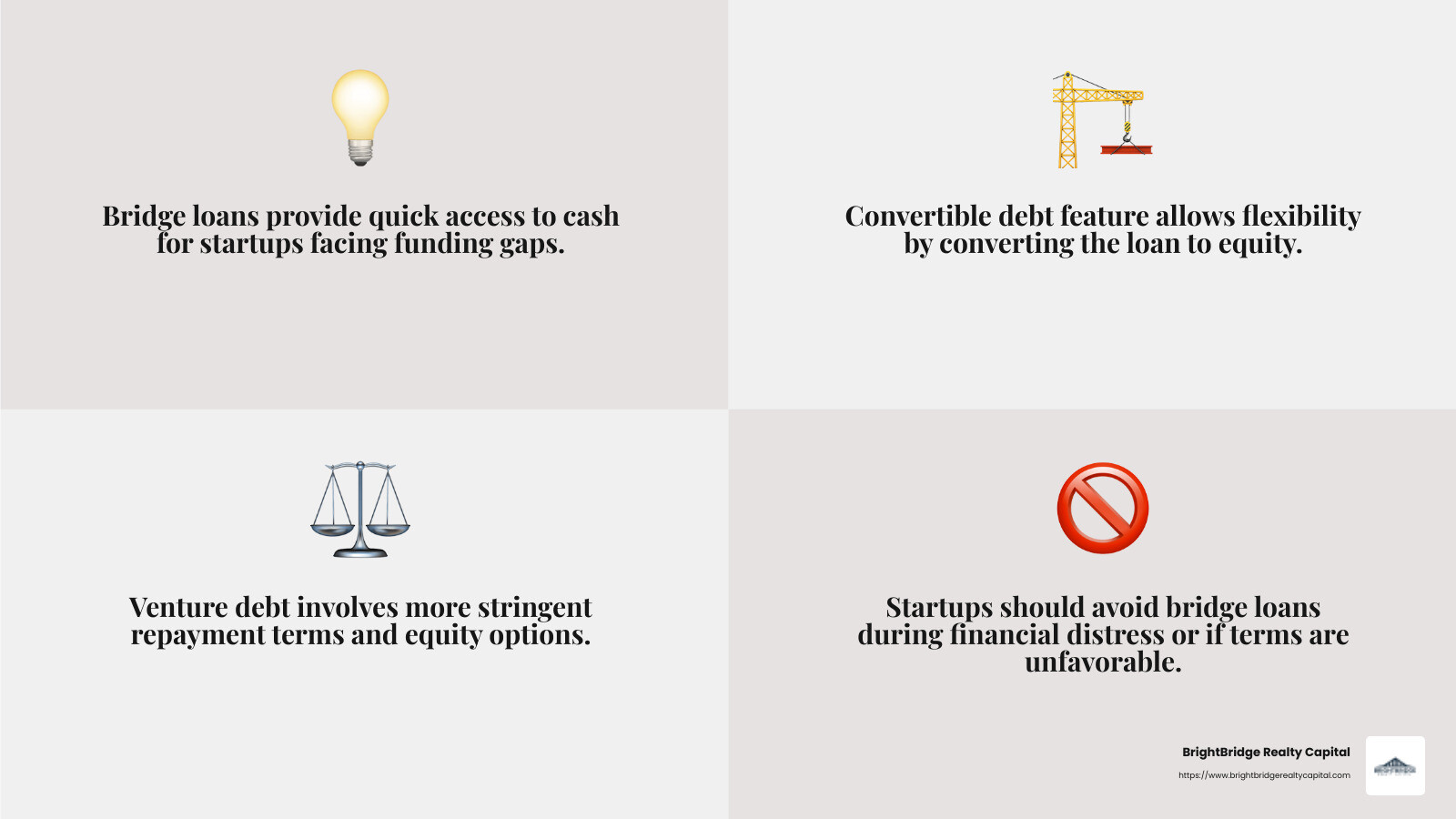Bridge Loans Unveiled: A Venture Capital Perspective

Bridge loan venture capital serves as a crucial financial lifeline for startups and growing businesses navigating uncertain and dynamic market conditions. With fluctuating cash flows and evolving funding needs, entrepreneurs often seek bridge financing to bypass short-term financial problems. This form of financing provides interim capital, allowing businesses to continue operations until they secure long-term funding or achieve strategic objectives.
- Bridge Financing Defined: Short-term loans that help businesses transition between financing rounds.
- Venture Capital's Role: Provides capital to startups, often filling gaps between major funding milestones.
- Benefits: Offers quick access to funds, ensuring business continuity and growth.
In a competitive venture capital landscape, with decreasing deal opportunities, bridge loans have emerged as a valuable tool. They enable startups to maintain momentum, meet investor milestones, and prepare for the next phase of their business journey, as highlighted in the recent market reports. The strategic use of bridge loans can be the difference between stagnation and the ability to seize potential growth opportunities.

Understanding Bridge Loans in Venture Capital
Bridge loans in venture capital act as a temporary financial solution for startups. They provide the necessary funds to bridge the gap between major financing rounds, ensuring that businesses can meet their immediate cash needs.
Temporary Funding for Startups
When startups face a delay in securing long-term funding, bridge loans offer a quick fix. They provide essential short-term capital, allowing startups to continue operations without interruption. This temporary funding is crucial, especially when startups are on the brink of achieving significant milestones that could attract future investors.
Equity Injection and Cash Needs
Bridge loans often come with the potential for equity injection. This means that the loan can convert into equity at a later stage, typically during the next funding round. This feature is particularly attractive to startups that may not have the cash flow to repay a traditional loan. Instead, they can offer equity to investors, aligning both parties' interests in the startup's success.
Startups often use bridge loans to address various cash needs, such as:
- Operating Expenses: Covering salaries, rent, and other day-to-day expenses.
- Business Development: Investing in marketing and sales efforts to boost growth.
- Product Development: Funding the final stages of product development to meet market demands.
By addressing these cash needs, bridge loans enable startups to maintain momentum and continue their growth trajectory.
The Venture Capital Perspective
From a venture capital standpoint, bridge loans are a strategic tool. They allow investors to support startups during critical phases, ensuring that these businesses have the resources needed to succeed. In a competitive market with fewer traditional funding opportunities, bridge loans provide a way for venture capitalists to maintain their investment portfolios and potentially increase their equity stake in promising startups.

In summary, bridge loans in venture capital are a lifeline for startups facing cash flow challenges. They offer temporary funding, potential equity benefits, and the means to meet immediate cash needs, thus playing a vital role in the startup ecosystem.
The Role of Bridge Loans in Startup Financing
Bridge loans play a crucial role in startup financing by serving as interim financing solutions. They help startups steer through funding gaps that occur between major investment rounds. This is particularly important in the current market where venture capital activities have become more selective.
Interim Financing: Keeping the Lights On
Startups often find themselves in a tight spot when they are close to achieving significant milestones but lack the necessary funds to get there. In such cases, bridge loans act as a lifeline. They provide the necessary capital to continue operations and make progress towards key goals.
For example, a startup might need funds to ramp up marketing efforts or finalize product development. A bridge loan can provide the immediate cash required to seize these opportunities without waiting for the next big investment round.
Funding Gaps: Bridging the Uncertainty
The venture capital landscape in 2023 has seen a notable decline in deal counts, with a 48.2% drop year-over-year. This has made it harder for startups to secure traditional Series A or B rounds. Bridge loans help fill the void by offering short-term funding that keeps startups afloat during these uncertain times.
These loans are especially beneficial when startups face unexpected delays in closing a new funding round. By securing a bridge loan, businesses can maintain steady operations and avoid disruptions that could jeopardize their growth.
Milestone Achievement: Reaching New Heights
Achieving specific milestones is often a prerequisite for securing future investment. Bridge loans empower startups to hit these targets by providing the necessary resources. Whether it's reaching a revenue goal or expanding the customer base, the funds from a bridge loan can be the difference between stagnation and success.
Consider the hypothetical scenario of a startup between its Series A and Series B rounds. By taking a bridge loan, the company can invest in vital areas like business development and marketing. This can lead to a 50% growth in revenue, making the startup more attractive to future investors and facilitating the next round of funding.
Bridge loans are not just about surviving the present; they are about positioning for future success. They enable startups to stay on course, achieve crucial milestones, and ultimately, secure long-term growth and sustainability.
Bridge Loan Venture Capital: Key Considerations
When it comes to bridge loan venture capital, decision-making is often clouded by cognitive biases and psychological traps. These mental shortcuts can lead VCs to make less-than-optimal choices, especially in high-stakes situations.
Cognitive Biases: The Invisible Influencers
Cognitive biases are systematic errors in thinking that affect decisions and judgments. In the venture capital world, these biases can distort the evaluation of a startup's potential, especially when deciding on bridge financing.
One common bias is groupthink, where the desire for harmony in a decision-making group leads to irrational or dysfunctional outcomes. If everyone in the VC firm agrees without critical evaluation, bad investments may follow.
Another bias is priming. For instance, if a VC has recently read about a successful startup turnaround, they might be more inclined to approve a bridge loan, expecting a similar outcome, even if the situations are not comparable.
Decision-Making: Navigating Uncertainty
Decision-making in venture capital is inherently uncertain. VCs often have to choose whether to reinvest in a struggling startup or cut their losses. This is especially tough when the startup's trajectory is unclear.
In these situations, it’s crucial to distinguish between uncertainty and ambiguity. Uncertainty involves unknown outcomes with estimable probabilities. Ambiguity, however, means both the outcomes and their probabilities are unclear.
For instance, during the early stages of disruptive technologies like AI, predicting success can feel like a shot in the dark. In such scenarios, relying solely on data is insufficient; VCs must also use judgment and experience to make informed decisions.
Psychological Traps: Avoiding the Pitfalls
Psychological traps can lead VCs to "throw good money after bad." This happens when they continue investing in a failing startup, hoping for a turnaround that never materializes.
A well-known trap is the sunk cost fallacy. VCs may feel compelled to continue funding a startup because they've already invested a significant amount, even when the prospects are bleak.
To avoid these traps, a structured approach is essential. Instead of relying on gut feelings, VCs should employ a systematic evaluation process, considering all available data and possible outcomes.
In conclusion, while bridge loans can be a vital tool for startups, they require careful consideration. By understanding and mitigating cognitive biases and psychological traps, VCs can make more informed and effective decisions.
Pros and Cons of Bridge Loans
Bridge loans are a popular choice in the startup world, providing quick financial relief when cash is tight. But like any financial tool, they come with their own set of advantages and drawbacks.
Pros:
Short-Term Commitment
One of the biggest perks of bridge loans is their short-term nature. Startups often need quick cash to get over a financial hump, and bridge loans fill that gap without long-term obligations. This makes them ideal for startups anticipating future funding rounds or other revenue events.
Quick Access
Speed is crucial in the world of startups. Bridge loans offer quick access to funds, often within days of application. This rapid turnaround can be a lifesaver when unexpected expenses arise or when a startup needs to seize a sudden opportunity. For instance, BrightBridge Realty Capital can provide substantial funding within a short timeframe, allowing startups to act swiftly when needed.
Cons:
Potential Dilution
A significant downside is the potential for equity dilution. Many bridge loans come with convertible options, meaning the loan can be converted into equity at a future date. This can lead to founders losing a portion of their ownership. It's essential for startups to weigh the cost of dilution against the benefits of immediate cash flow.
Higher Interest Rates
Given their short-term nature and the risk involved, bridge loans often come with higher interest rates compared to traditional loans. This can lead to increased financial pressure on the startup, especially if the expected funding round takes longer to materialize.
In summary, bridge loans offer a quick and flexible solution for startups facing immediate cash needs. However, consider the potential for equity dilution and higher interest rates before proceeding. Understanding these pros and cons can help startups make informed decisions that align with their long-term goals.
Frequently Asked Questions about Bridge Loans
What are bridge loans typically used for?
Bridge loans are like financial band-aids for startups. They're designed to provide temporary relief when cash flow is tight. Startups often use them to cover working capital needs, such as payroll or rent, when waiting for more substantial funding. They also help in achieving milestone funding—reaching specific business goals that open up future investment rounds.
For instance, a startup might take a bridge loan to ramp up marketing efforts and hit a revenue target that convinces investors to commit to the next funding round. This way, bridge loans act as a bridge between where the startup is now and where it needs to be to secure further investment.
How do bridge loans differ from venture debt?
Bridge loans and venture debt are both tools for raising capital, but they have key differences. Bridge loans are typically convertible debt, which means they can be converted into equity in the future. This feature allows startups to delay repayment until they have more financial stability.
In contrast, venture debt often involves more complex equity options and may require startups to give up warrants or other forms of equity compensation to the lender. Venture debt also tends to have more stringent repayment terms, often tied to performance milestones or specific revenue targets.
While bridge loans offer quick access to funds with the possibility of conversion to equity, venture debt is usually more structured, with a focus on long-term growth and stability.
When should a startup avoid taking a bridge loan?
Not every startup situation is ideal for a bridge loan. Here are some scenarios where it might be better to steer clear:
Financial Distress: If a startup is on the brink of bankruptcy, taking on more debt can worsen the situation. Debt holders will have preferred liquidation rights, which can leave current shareholders with little to nothing.
Unclear Capital Needs: It's risky to take a loan without knowing exactly how much you need or what you'll use it for. Startups should have a clear forecast and plan before taking on a bridge loan.
Unfavorable Terms: In desperate situations, some lenders might impose one-sided terms that can negatively impact corporate governance. It's crucial to understand all terms and conditions before proceeding.
In these cases, it's wise for startups to explore other funding options or wait until they're in a more stable financial position.

Conclusion
In venture capital, bridge loans are a crucial tool for startups. They provide temporary relief when cash flow is tight and help companies reach the next milestone in their growth journey. But not all bridge loans are created equal. That's where we at BrightBridge Realty Capital come in.
We specialize in providing customized real estate financing solutions that are custom to meet the unique needs of each investor. Our approach is straightforward: we offer fast closings, often within a week, and direct lending without intermediaries. This means you get competitive rates and a seamless process, making it easier for you to take advantage of opportunities as they arise.
Our nationwide reach ensures that no matter where your investment properties are located, you have access to the capital you need. Whether you're flipping properties, building from the ground up, or expanding a rental portfolio, our bridge loans can help you keep your projects on track and your investment strategy moving forward.
Choosing the right type of financing is essential for your success. With our expertise and commitment to fast, flexible funding, BrightBridge Realty Capital is your partner in navigating the complexities of bridge loan venture capital. Explore our customized solutions today and find how we can help you bridge the gap to your next success.


